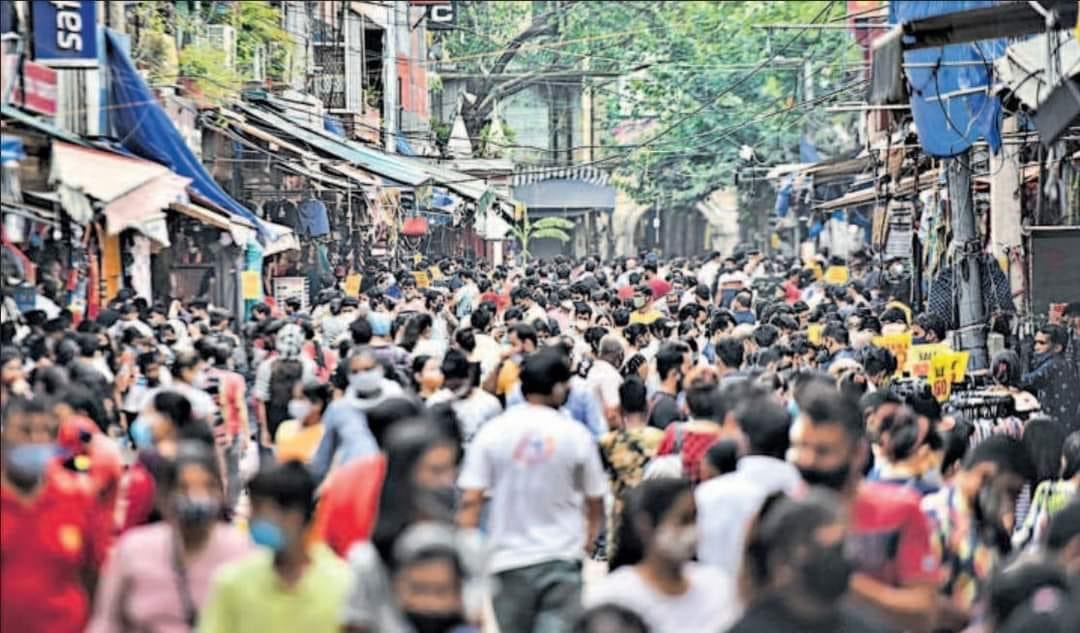
India set to pip China as most populous country: Is it a good thing?
While many blame most of India's evils on its humongous population, others ague that it’s the nation’s strength, not weakness

India is all set to wrest from China the title of the world’s most populous country in April. The neighbour has held the distinction ever since the UK population records began in 1950. In fact, India may have already earned its crown because exact population figures are difficult to calculate. The UN’s estimates are mere projections and India has not conducted a census since 2011.
India’s burgeoning population has been a topic of heated debate for long, including in politics. While many blame most of the country’s evils on its humongous population, others ague that it’s the nation’s strength, not weakness. Even as China successfully implemented its one-child policy, curbing its rapid population growth, India has never tried to enforce such rigorous norms, barring Sanjay Gandhi’s controversial sterilisation programme in the mid-1970s.
Also read: India top contributor with added 177 m as world population touches 8 b
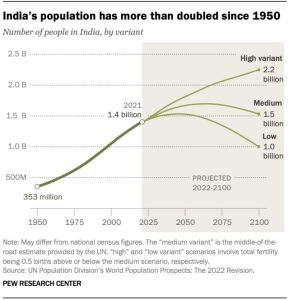 According to information collated by Pew Research Center, based on analyses of data from the UN and other sources, India has added more than a billion people to its population since 1950. Its current estimated population is more than 1.4 billion — nearly double that of entire Europe (744 million) and far exceeding that of the Americas (1.04 billion).
According to information collated by Pew Research Center, based on analyses of data from the UN and other sources, India has added more than a billion people to its population since 1950. Its current estimated population is more than 1.4 billion — nearly double that of entire Europe (744 million) and far exceeding that of the Americas (1.04 billion).
Even by conservative estimates, which is the UN’s “medium variant” projection, India’s population will cross 1.5 billion by the end of this decade and peak at 1.7 billion in 2064. The UN’s “high variant” scenario projects India’s population to cross 2 billion by 2068. In the UN’s “low variant” scenario, India’s population will start declining from 2047 and fall to 1 billion people by 2100.
So, are India’s growing population and the title of being the most populous nation healthy for it?
Falling fertility rates
As worrisome as these projections may sound, India’s fertility rate has already been declining in recent decades. The average Indian woman has two children in her lifetime, as against China’s 1.2 or the US’s 1.6. But the figure has dropped drastically since 1992 (3.4) or 1950 (5.9).
Also read: South’s share in Indian population lowest in 2022: Census estimates
That fall in fertility rate has been consistent for every religious group in the country, including Hindu, Muslim, Christian, Sikh, Buddhist, and Jain. Fertility rate remains the highest among Indian Muslims among all major religious groups, but even for them, the rate has come down dramatically from 4.4 children per woman in 1992 to 2.4 in 2019.
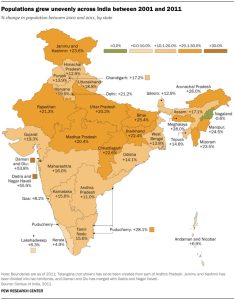 However, the urban-rural divide is striking when it comes to fertility rates, with women in rural areas having an average of 2.1 children in their lifetime, while their urban sisters have only 1.6, according to the 2019-21 National Family Health Survey (NFHS) date. Twenty years ago, the respective figures were 3.7 and 2.7 children, respectively.
However, the urban-rural divide is striking when it comes to fertility rates, with women in rural areas having an average of 2.1 children in their lifetime, while their urban sisters have only 1.6, according to the 2019-21 National Family Health Survey (NFHS) date. Twenty years ago, the respective figures were 3.7 and 2.7 children, respectively.
Fertility rates also vary greatly by state, with Bihar (2.98) and Meghalaya (2.91) having the highest rates and Sikkim (1.05) and Goa (1.3) having the lowest.
Similarly, population growth has also varied across states. The populations of Meghalaya and Arunachal Pradesh increased by 25% or more between 2001 and 2011, while those of Goa and Kerala increased by less than 10% in that time, and Nagaland’s shrank by 0.6%.
Narrowing sex ratio and dropping infant mortality
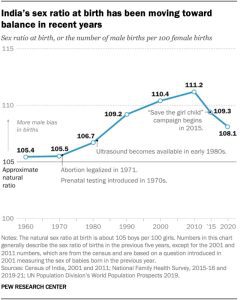 Another positive trend is that India’s artificially wide sex ratio has been narrowing. It went up in the 1970s when prenatal diagnostic technology was introduced and started being used to conduct sex-selective abortions.
Another positive trend is that India’s artificially wide sex ratio has been narrowing. It went up in the 1970s when prenatal diagnostic technology was introduced and started being used to conduct sex-selective abortions.
From 111 boys per 100 girls in the 2011 census, the sex ratio has narrowed to about 109 boys per 100 girls in the 2015-16 NFHS, and 108 boys per 100 girls in the 2019-21 NFHS. According to a 2022 Pew Research Center study, the average number of baby girls going “missing” annually fell from about 480,000 in 2010 to 410,000 in 2019.
Watch: Does India need a population control policy? Decoding facts and myths
A major reason for India’s population growth is that with improving health care, India’s infant mortality has decreased by 70% in the past three decades. From 89 deaths per 1,000 live births in 1990, the figure came down to 27 in 2020.
Yet, India’s infant mortality rate remains higher than those of neighbours Bangladesh (24), Nepal (24), Bhutan (23), and Sri Lanka (6), and much higher than its peers in population size, China (6) and the US (5).
Growing young population
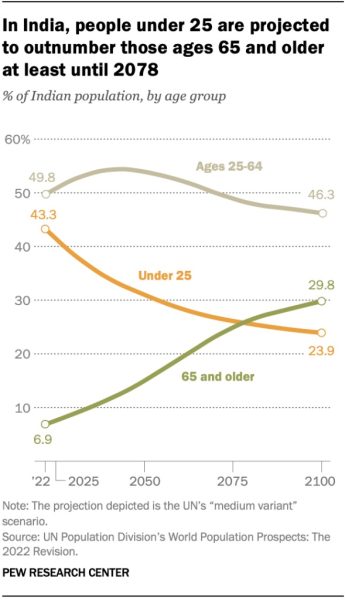 One of India’s biggest strengths is said to be its growing youth population. More than 40% of India’s population is aged under 25 — which means around one in five people globally aged under 25 lives in India. While India’s median age is 28, it is 38 in the US and 39 in China.
One of India’s biggest strengths is said to be its growing youth population. More than 40% of India’s population is aged under 25 — which means around one in five people globally aged under 25 lives in India. While India’s median age is 28, it is 38 in the US and 39 in China.
While Japan’s aging population is widely spoken about, China and the US, too, have rapidly aging populations — unlike India. People aged 65 or older comprise only 7% of India’s population, compared with 14% in China and 18% in the US, according to the UN.
Also read: India has 115 cr mobile subscribers; 98% population has access to 4G
Analysts say that India’s burgeoning population can offer enormous opportunity for economic growth, provided the country can harness the potential. And its young population — which can adapt quickly and can keep pace with the dramatic and constant technological change — will be a major driving force in its expansion.
The positive side of India’s humongous population was seen during the COVID-19 pandemic, when rising domestic consumption helped the nation tide over the external shock. Industry analysts believe with its abundant supply of labour, India should invite more foreign investments.
S&P Global predicts that India will overtake Germany and Japan to become the third-largest economy by 2030, with annual nominal GDP growth projected to average 6.3%.
The flipside
However, before India’s growing youth population can add to its economic growth, it needs to survive. The country urgently needs to create jobs for the millions joining its workforce each year and ensure they have the right education and the right skills to fill those roles.
However, unemployment is rising in India. Unemployment grew to 8.30% in December, which was the highest in 16 months, according to Centre for Monitoring Indian Economy data. Only 5% of India’s workforce is formally skilled, even though it is the largest and youngest in the world, says World Economic Forum data.
Also read: India’s richest 1% own more than 40% of total wealth: Oxfam report
India’s wealth inequality is clearly a challenge, which could worsen as the population grows. Wealth inequality has already been growing in recent decades, with the top 10% of the population owning more than 60% of India’s total wealth, show figures from the World Inequality Database. The lower 50% has only 6% of the country’s wealth.
India’s GDP per capita in 2021 stood at USD 2,256, according to the World Bank.

